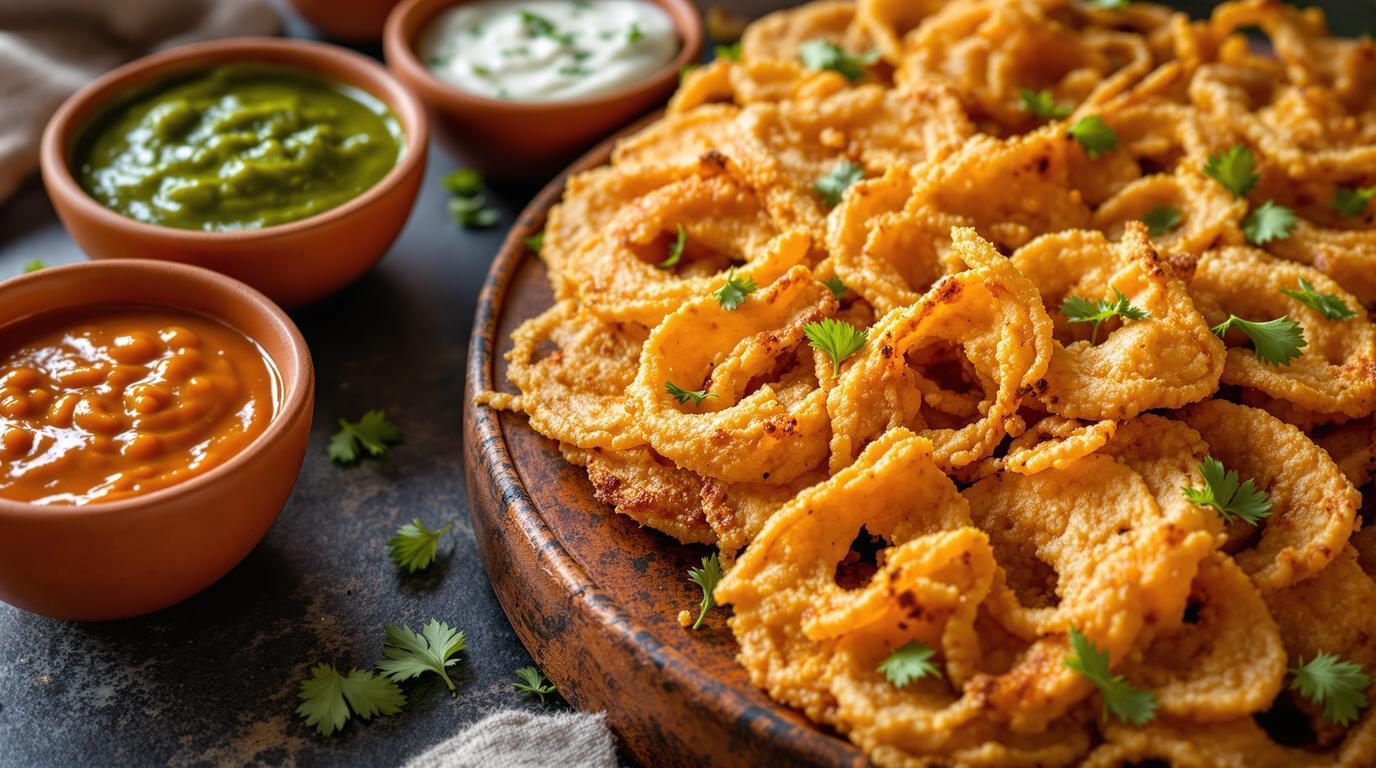I still remember the first time I made proper onion bhajis at home. After years in professional kitchens, I was humbled by an elderly woman in a small Punjabi village who showed me how wrong I’d been doing it. “The secret,” she whispered, “is in how you treat the onions before they ever touch the batter.” That lesson transformed my approach to this iconic street food. These crispy, aromatic fritters aren’t just appetizers – they’re an exercise in technique that rewards patience with incredible texture and flavor.
The Story
Onion bhajis trace their roots to South Asian street food culture, where vendors perfect the balance between a shatteringly crisp exterior and tender, flavor-packed interior. What distinguishes a truly exceptional bhaji is respecting the onion itself – treating it as the star rather than merely a vehicle for batter. The traditional grandmother-style approach I’m sharing today focuses on moisture management and minimal intervention, allowing the natural sweetness of the onions to shine through while achieving that coveted crispy texture. I’ve adapted this time-honored technique the same way I approach traditional Italian dishes – with respect for tradition but an eye for modern execution.
Ingredients Spotlight
For 12-15 bhajis:
- 3 large red onions (approximately 450g/1lb), thinly sliced
- 165g (1½ cups) besan/gram flour
- 40g (¼ cup) rice flour
- 1 teaspoon kosher salt, plus more for sprinkling
- 2 teaspoons cumin seeds
- 1 teaspoon ground coriander
- ½ teaspoon chili flakes (adjust to your heat preference)
- ¼ cup fresh coriander leaves, finely chopped
- ⅛ teaspoon baking soda
- 1-3 tablespoons water (only if needed)
- Vegetable oil for deep frying
Step-by-Step Guide
1. Prep the onions: Slice onions into thin half-moons. Place in a bowl, sprinkle with 1 teaspoon salt, and toss thoroughly. Let sit for 15 minutes – this critical step draws out moisture and concentrates flavor.
2. Prepare the dry mix: In a large bowl, combine gram flour, rice flour, cumin seeds, coriander powder, chili flakes, and baking soda. Mix thoroughly.
3. Handle the salted onions: After resting, gently squeeze handfuls of the onions to release excess moisture. Save this liquid! It’s packed with flavor and will be the primary moisture for your batter.
4. Create the batter: Add onions to the dry ingredients. Pour in the reserved onion liquid and mix with your hands, coating every strand of onion. The mixture should just hold together when squeezed – add 1 tablespoon of water at a time only if absolutely necessary.
5. Heat the oil: In a heavy-bottomed pan, heat oil to 190°C/375°F (use a thermometer for precision). Test with a small piece of batter – it should sizzle immediately and float.
6. Fry the bhajis: Take golf ball-sized portions of the mixture, gently press into rough discs, and lower carefully into the hot oil. Fry 3-4 at a time for 2-3 minutes per side until deeply golden brown.
7. Drain and season: Remove with a slotted spoon and drain on paper towels. Sprinkle with a pinch of salt while still hot.
Expert Techniques
The most common mistake I see is over-hydrating the batter. Your instinct might say “add water” when the mixture looks dry, but resist! The natural moisture from the onions is sufficient. If you’ve ever had soggy bhajis, excess water was likely the culprit.
Chef’s Note: Temperature control is crucial here. If your oil is too hot, the outside will burn before the interior cooks; too cool, and they’ll absorb oil and become greasy. I use the wooden spoon test as backup – bubbles should form around the handle when it’s ready.
For perfectly uniform slices that cook evenly, I recommend using a mandoline for the onions – just watch those fingertips! The thinner the slices, the more delicate and lacy your bhajis will be, similar to the technique used in exceptional pizza bianca.
Presentation & Pairing Ideas
Serve your bhajis immediately after cooking for maximum crispness. I arrange them in a spiral on a large platter with three distinct dipping sauces:
- Mint-coriander chutney (herbaceous and bright)
- Tamarind-date chutney (sweet and tangy)
- Cucumber yogurt raita (cooling contrast)
For a complete experience, pair with a crisp rosé or a hoppy IPA – both cut through the richness beautifully. These bhajis also make an excellent starter before a richer main like beef bourguignon, creating a fascinating fusion experience.
For a lighter option, these can be baked at 220°C/425°F for 15-20 minutes, though the texture will differ from traditional deep-fried versions. For dessert, consider continuing the international theme with classic French madeleines or chocolate pistachio brownies.
The beauty of bhajis lies in their adaptability. Once you master the basic technique, experiment with different spice combinations – fennel seeds add wonderful anise notes, while garam masala brings warmth and complexity. The crispy exterior, sweet onion interior, and punchy spices create a perfect bite that’s worth every minute spent perfecting your technique. Remember: respect the onion, manage the moisture, and you’ll create bhajis worthy of any grandmother’s approval. 🍽️
